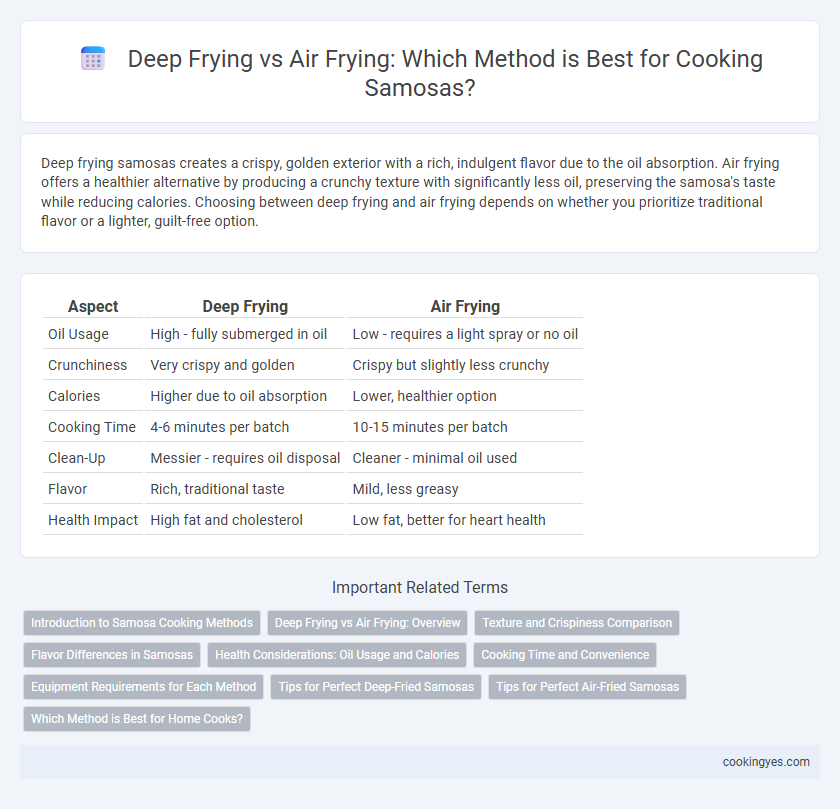Deep frying samosas creates a crispy, golden exterior with a rich, indulgent flavor due to the oil absorption. Air frying offers a healthier alternative by producing a crunchy texture with significantly less oil, preserving the samosa's taste while reducing calories. Choosing between deep frying and air frying depends on whether you prioritize traditional flavor or a lighter, guilt-free option.
Table of Comparison
| Aspect | Deep Frying | Air Frying |
|---|---|---|
| Oil Usage | High - fully submerged in oil | Low - requires a light spray or no oil |
| Crunchiness | Very crispy and golden | Crispy but slightly less crunchy |
| Calories | Higher due to oil absorption | Lower, healthier option |
| Cooking Time | 4-6 minutes per batch | 10-15 minutes per batch |
| Clean-Up | Messier - requires oil disposal | Cleaner - minimal oil used |
| Flavor | Rich, traditional taste | Mild, less greasy |
| Health Impact | High fat and cholesterol | Low fat, better for heart health |
Introduction to Samosa Cooking Methods
Deep frying samosas ensures a crispy, golden exterior and evenly cooked filling due to the high-temperature oil immersion, preserving traditional flavors and textures. Air frying offers a healthier alternative by circulating hot air to cook the samosas, reducing oil absorption while maintaining a satisfying crunch. Both methods cater to different preferences, balancing taste, texture, and nutritional considerations in samosa preparation.
Deep Frying vs Air Frying: Overview
Deep frying samosas results in a crispy, golden exterior with a rich, indulgent flavor due to oil absorption, while air frying offers a healthier alternative by using hot air circulation to produce a similarly crispy texture with significantly less oil. Deep frying can lead to higher calorie content and potential oil residue, whereas air frying maintains lower fat content and reduces the risk of oil-based contaminants. Both methods affect the samosa's texture and taste differently, with deep frying favored for traditional authentic flavor and air frying preferred for health-conscious preparation.
Texture and Crispiness Comparison
Deep frying samosas produces a golden, evenly crisp exterior with a rich, indulgent texture due to the hot oil infusing the pastry. Air frying yields a lighter, less oily crispness but can result in a slightly drier and less uniformly crunchy samosa surface. Texture differences are significant: deep-fried samosas have a flaky, supple crust, while air-fried versions often feature a firmer, more brittle crunch.
Flavor Differences in Samosas
Deep frying samosas results in a rich, crispy texture with a pronounced golden-brown exterior and a deep, savory flavor due to the oil absorption. Air frying samosas produces a lighter, less oily crust with a subtler taste that highlights the filling's spices without the heaviness of deep frying. The difference in cooking methods significantly influences the overall flavor profile and mouthfeel, with deep frying offering a more indulgent experience and air frying providing a healthier, crisper alternative.
Health Considerations: Oil Usage and Calories
Deep frying samosas involves submerging them in hot oil, significantly increasing the calorie content due to oil absorption, which can contribute to higher fat intake and related health risks. Air frying uses minimal to no added oil, reducing calories and unhealthy fats while still achieving a crispy texture, making it a healthier cooking alternative. Choosing air frying over deep frying helps lower the risk of heart disease and obesity by limiting excessive oil consumption and calorie intake.
Cooking Time and Convenience
Deep frying samosas typically takes about 3-5 minutes to achieve a crispy, golden texture, but involves handling hot oil and requires careful monitoring to prevent burning. Air frying samosas reduces cooking time to around 10-15 minutes with little to no oil, offering a more convenient and less messy method suitable for quick preparation. Both methods provide crispy results, but air frying enhances convenience and promotes healthier cooking without sacrificing texture.
Equipment Requirements for Each Method
Deep frying samosas requires a heavy-bottomed deep fryer or a large, deep pan with sufficient oil to ensure even cooking and crispiness, along with a slotted spoon or spider strainer for safe handling. Air frying samosas necessitates an air fryer equipped with a basket or tray that allows hot air circulation, minimizing oil usage while still achieving a crispy texture. Each method demands distinct equipment--deep frying emphasizes oil and temperature control tools, whereas air frying relies on advanced heat convection technology for healthier preparation.
Tips for Perfect Deep-Fried Samosas
Achieve perfectly crisp deep-fried samosas by maintaining oil temperature around 350degF (175degC) to ensure even cooking and prevent sogginess. Use fresh, neutral oil like sunflower or canola and avoid overcrowding the pan, allowing proper heat circulation. Drain excess oil on paper towels immediately after frying for a crisp texture and enhance flavor by seasoning samosas right after frying.
Tips for Perfect Air-Fried Samosas
For perfect air-fried samosas, preheat the air fryer to 375degF (190degC) and lightly brush or spray the samosas with oil to achieve a crispy texture similar to deep frying. Arrange samosas in a single layer to ensure even cooking and shake the basket halfway through for uniform browning. Cook for 12-15 minutes or until golden brown, avoiding overcrowding to prevent sogginess and maintain the ideal crunch.
Which Method is Best for Home Cooks?
Deep frying samosas delivers a traditional crispy texture and rich flavor but involves higher oil consumption and longer cleanup, which may be less convenient for home cooks. Air frying offers a healthier alternative by significantly reducing oil usage while producing a crisp exterior with a slightly different texture, making it ideal for those prioritizing health and ease. For home cooks seeking a balance between taste and convenience, air frying is often the best method due to its efficiency and reduced fat content.
Deep frying vs air frying for samosa cooking Infographic

 cookingyes.com
cookingyes.com